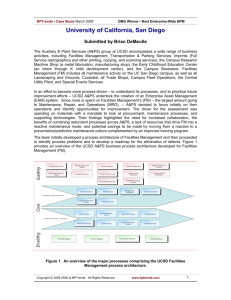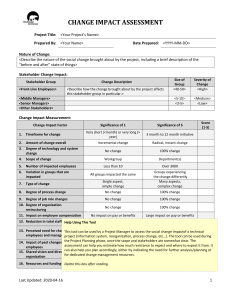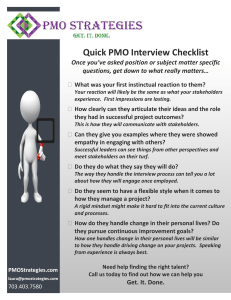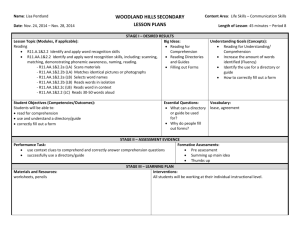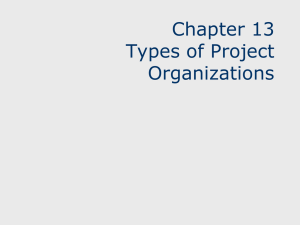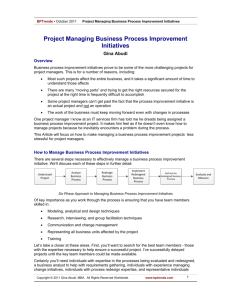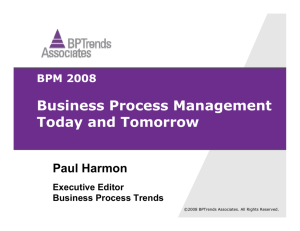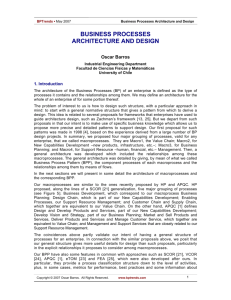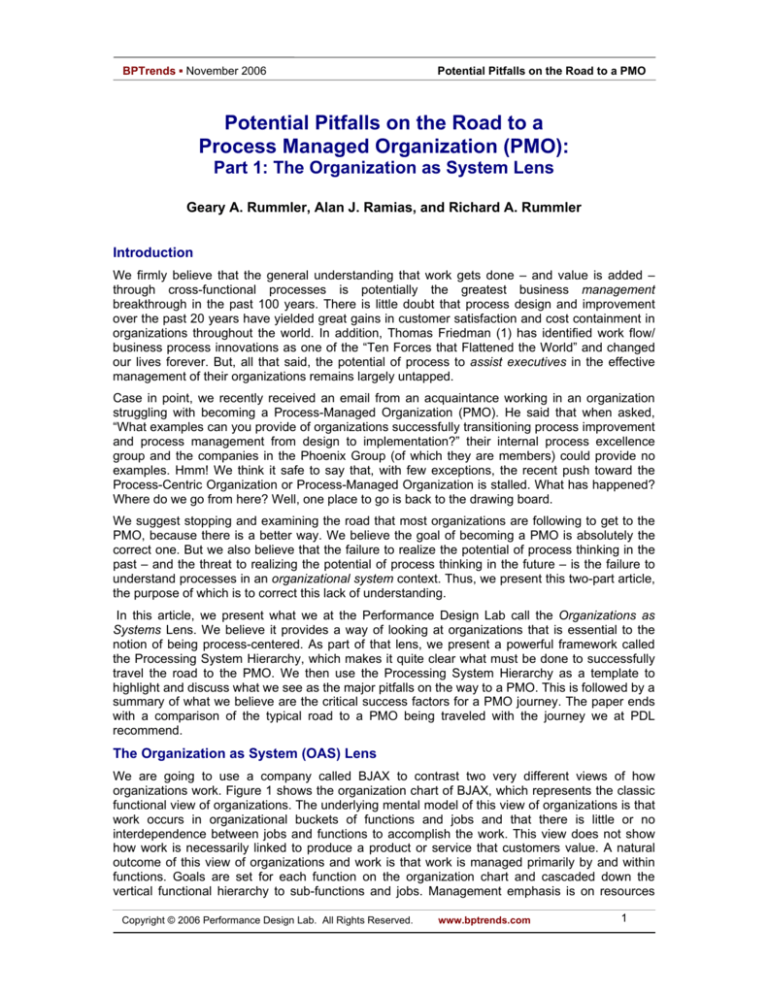
BPTrends ▪ November 2006
Potential Pitfalls on the Road to a PMO
Potential Pitfalls on the Road to a
Process Managed Organization (PMO):
Part 1: The Organization as System Lens
Geary A. Rummler, Alan J. Ramias, and Richard A. Rummler
Introduction
We firmly believe that the general understanding that work gets done – and value is added –
through cross-functional processes is potentially the greatest business management
breakthrough in the past 100 years. There is little doubt that process design and improvement
over the past 20 years have yielded great gains in customer satisfaction and cost containment in
organizations throughout the world. In addition, Thomas Friedman (1) has identified work flow/
business process innovations as one of the “Ten Forces that Flattened the World” and changed
our lives forever. But, all that said, the potential of process to assist executives in the effective
management of their organizations remains largely untapped.
Case in point, we recently received an email from an acquaintance working in an organization
struggling with becoming a Process-Managed Organization (PMO). He said that when asked,
“What examples can you provide of organizations successfully transitioning process improvement
and process management from design to implementation?” their internal process excellence
group and the companies in the Phoenix Group (of which they are members) could provide no
examples. Hmm! We think it safe to say that, with few exceptions, the recent push toward the
Process-Centric Organization or Process-Managed Organization is stalled. What has happened?
Where do we go from here? Well, one place to go is back to the drawing board.
We suggest stopping and examining the road that most organizations are following to get to the
PMO, because there is a better way. We believe the goal of becoming a PMO is absolutely the
correct one. But we also believe that the failure to realize the potential of process thinking in the
past – and the threat to realizing the potential of process thinking in the future – is the failure to
understand processes in an organizational system context. Thus, we present this two-part article,
the purpose of which is to correct this lack of understanding.
In this article, we present what we at the Performance Design Lab call the Organizations as
Systems Lens. We believe it provides a way of looking at organizations that is essential to the
notion of being process-centered. As part of that lens, we present a powerful framework called
the Processing System Hierarchy, which makes it quite clear what must be done to successfully
travel the road to the PMO. We then use the Processing System Hierarchy as a template to
highlight and discuss what we see as the major pitfalls on the way to a PMO. This is followed by a
summary of what we believe are the critical success factors for a PMO journey. The paper ends
with a comparison of the typical road to a PMO being traveled with the journey we at PDL
recommend.
The Organization as System (OAS) Lens
We are going to use a company called BJAX to contrast two very different views of how
organizations work. Figure 1 shows the organization chart of BJAX, which represents the classic
functional view of organizations. The underlying mental model of this view of organizations is that
work occurs in organizational buckets of functions and jobs and that there is little or no
interdependence between jobs and functions to accomplish the work. This view does not show
how work is necessarily linked to produce a product or service that customers value. A natural
outcome of this view of organizations and work is that work is managed primarily by and within
functions. Goals are set for each function on the organization chart and cascaded down the
vertical functional hierarchy to sub-functions and jobs. Management emphasis is on resources
Copyright © 2006 Performance Design Lab. All Rights Reserved.
www.bptrends.com
1
BPTrends ▪ November 2006
Potential Pitfalls on the Road to a PMO
expended by each function. What is not addressed in any satisfactory way by this view of
organizations, work, and work management, is the critical objective of delivering value to one’s
customers.
Figure 1 BJAX Organization Chart
Figure 2 presents a very different view of organizations. To begin with, when looking at Figure 2,
substitute “BJAX” for “Any Enterprise.” The mental model here is that BJAX (and most every
organization under the sun) can be viewed as being a system.
This view of an organization can lead to a revolutionary change in how organizations are
managed and to significant improvements in their performance. The basic Organization as
System (2) premises are:
All organizations are systems
BJAX is a system that exists to produce valued outputs to two constituencies:
• Desired products or services for customers.
• An economic return to financial stakeholders who have underwritten the existence of the
organization entity.
Copyright © 2006 Performance Design Lab. All Rights Reserved.
www.bptrends.com
2
BPTrends ▪ November 2006
Potential Pitfalls on the Road to a PMO
Figure 2. The Organization as a System Lens
Organizations are adaptive systems
Referring to Figure 2, the BJAX (or ANY ENTERPRISE) box represents the BJAX organization
system, which exists in a larger Super-System. The critical point is that BJAX must continuously
adapt to changes in its Super-System, including changes in:
The consumer marketplace
The capital marketplace
Competition
Resources/Supply Chain
The general business environment of
o The economy
o Culture
o Natural Environment
o Governmental/regulatory
o Geo-political circumstances
The Super-System is the ultimate performance reality and performance context for every
organization. Bluntly put, BJAX must adapt to the reality of its Super-System or die.
Organizations are processing systems
Shifting our focus inside the BJAX box in Figure 2, we argue every business is a machine that
takes in inputs (i.e., customer needs) and converts them or transforms them into outputs valued
by customers. In so doing, the business consumes or utilizes key resources such as capital,
technology, human resources, materials, and equipment. A business is a value machine,
producing value for both its constituencies – customers and investors. A very important distinction
between the view of organizations in Figure 1 and Figure 2 is that the latter view recognizes that
work flows horizontally across the functions of an organization to provide a valued product or
service to the customer. Implicit in this view is that regardless of the functional boundaries,
Copyright © 2006 Performance Design Lab. All Rights Reserved.
www.bptrends.com
3
BPTrends ▪ November 2006
Potential Pitfalls on the Road to a PMO
participants in these work activities must communicate and collaborate across organizational
lines to carry out their duties.
Process Definition
To better understand the issues around establishing a PMO, we are going to examine the
Organizations as Processing Systems notion more closely. But before we do that, it is necessary
to introduce a slightly different (but critical) definition of “process.”
All shape and manner of things are called processes these days. A common definition of process
goes something like this: “A chain of activities that converts various inputs into valued outputs.”
We would argue that that definition is more a description of the characteristics of a process. We
also argue that “process” is without a doubt the most effective way to articulate the value-added
work to be done in an organization. Therefore, our viewpoint is that “process” is a construct or
artifice for articulating and organizing work in a way that meets three critical criteria:
First, so that the work can be effectively and efficiently performed. Most everyone would agree
with that.
Second, so it can be effectively managed. This is new. In the past, the major emphasis on
organizing work has been effective and efficient performance of the work – effective management
of the work has been overlooked. Frequently overlooked is the need to organize work so that
management has the ability to plan and track performance and fix accountability. Take the
assembly of an automobile engine as an example:
• Process engineers would ordinarily group activities and parts into sub-assemblies that
come together at critical points so the process will be both effective (high quality output)
and efficient (minimum cost and throughput time).
• But if at the end of the process the engine fails to work as required, there are important
questions regarding the management of the assembly process: Why/where did the
engine fail? Where in the assembly process is the cause of this failure? In what
component? With what combination of components? These are questions that the
managers need to ask and be able to find the answers. In addition to efficiency and
effectiveness, the work must also be designed and organized to give management
visibility into the process.
In addition, the management system itself can be a root cause of poor performance in work
processes. A classic example is the product development process that is so burdened with
project reviews and multiple sign-offs that the company fails to get its new products to market in
time to beat the competition.
Organizing work so that it can be effectively managed is a critical criterion for intelligent work
design.
Third, wherever practical, work should be organized within a business so as to provide that
business with a competitive advantage. This criterion is adapted from the work of Michael Porter
(3), who has said:
• “A company outperforms rivals only if it can establish a difference that it can preserve.
Ultimately, all differences between companies…derive from the hundreds of activities
required to create, produce, sell, and deliver their products and services.”
• “The essence of strategy is in the activities – choosing to perform activities differently or
to perform different activities than rivals.”
• “Competitive advantage comes from the way… activities fit and reinforce one another.”
In the context of the engine assembly example above, Ford Motor Company should design and
organize its engine assembly process in a way difficult for its competitors to duplicate without
years of effort and expense.
Copyright © 2006 Performance Design Lab. All Rights Reserved.
www.bptrends.com
4
BPTrends ▪ November 2006
Potential Pitfalls on the Road to a PMO
(Note that this third criterion for organizing work provides an interesting link between the
organization as a processing system and the organization as an adaptive system. We are arguing
that one criterion for organizing work is the need of the organization to continually adapt to the
Super-System and to maintain a competitive advantage.)
So this is our definition: PROCESS is a construct or artifice for organizing work so it
•
•
•
Can be Performed effectively and efficiently
Offers the potential for a competitive advantage
Can be Managed effectively
There is an important assumption underlying this definition of process – that a process is not
some God-given sequence of work, chiseled in stone. Yes, the process engineers (or their
equivalent) laid out a sequence of steps that meet the “work performed” criterion. But this isn’t the
only criterion for organizing work. There is a pile of work activities required to produce any valued
output, and, in most cases, there are options as to how that work is designed and organized.
When organizing work (defining a process), there is the opportunity (and perhaps the obligation)
to exercise some imagination and creativity. In those organizations where people chasing the
PMO grail have spent many, many hours in merely documenting their processes, they should
realize that all this activity has contributed little to making the organization perform any better.
And what often happens is that those who have put in such Herculean effort to document their
processes then become reluctant to change them. A process map is always an imperfect
representation – at best a snapshot from a particular time and viewpoint – yet all the while the
actual process is changing.
The Processing System Hierarchy
Now let’s take a closer look at the diagram in Figure 3, which spells out our view of the structure
of work in an organization. The Processing System Hierarchy is a top to bottom framework for
organizing work in a way that meets all three of our criteria for organizing work:
•
•
•
Work structured and sequenced according to the Processing System Hierarchy lends
itself to being effectively and efficiently performed.
Where feasible, there is a uniqueness to the work structure and sequence that has the
potential for a competitive advantage for the business.
Work structured and sequenced this way can be effectively managed.
Also, this framework provides a context for identifying and explaining many of the pitfalls that
plague PMO efforts. It is the failure to understand this fundamental framework for structuring work
that has tripped up many PMO efforts in the past and will continue to do so in the future.
That said, let’s examine the Processing System Hierarchy.
Level 1 – Enterprise/Business Model
Referring to Figure 3, in place of “Any Enterprise,” read “BJAX,” which sits in a super-system, as
we have previously described.
The Enterprise/BJAX is made up of revenue producing businesses that conceive, sell, and deliver
valued products/services to customers. The Enterprise business goals are achieved through the
performance of the business units. The business units are the basic engines which deliver the
value and generate the revenue of the Enterprise. This collection of business units, and their
methods for creating value and generating profitable returns, reflects the Enterprise’s Business
Model.
Copyright © 2006 Performance Design Lab. All Rights Reserved.
www.bptrends.com
5
BPTrends ▪ November 2006
Potential Pitfalls on the Road to a PMO
Figure 3. Processing System Hierarchy
Copyright © 2006 Performance Design Lab. All Rights Reserved.
www.bptrends.com
6
BPTrends ▪ November 2006
Potential Pitfalls on the Road to a PMO
Each business unit is part of its own extended Value Chain (from suppliers to customer’s
customers) and has its own management system and unique super-system including
• Markets
• Competitors
• Resource requirements (and, possibly, sources)
Business environment (particularly as regards legal and regulatory requirements)
Because each business unit operates in its own unique super-system, each requires its own
strategy to determine how it will successfully compete in its market given the dynamics of its ever
changing super-system.
Determining exactly how to organize businesses around products/services and markets (i.e.,
determining a business model) is the first set of decisions regarding the organization of work.
Those decisions are, in fact, all about how to organize the work of the Enterprise so it can be
performed effectively and efficiently, can be managed effectively, and offers the potential for
establishing a sustainable competitive advantage. Failure to adapt an effective business model is
a fundamental strategic misstep that cannot easily be overcome through subsequent tactical
adjustments and maneuvers. (4)
Although we can think of the entire Enterprise as a giant processing system, the businesses are
really the starting point for serious process thinking. The business unit provides the business
context for processes and is the first link in the connection of process results to organization
results.
Let’s examine these three levels in Figure 3, as a whole. They make up the core of the
Processing System Hierarchy. And note, at each level we want to organize the work so that it can
be effectively performed and managed and offers the potential for a competitive advantage.
Level 2 – Value Chain
To provide value, a business must do three things, as represented by the three Primary
Processing Systems that make up the Value Chain.
• Identify the customer’s needs for a product/service and then find, conceive, invent, and/or
design a product/service to meet that need. (Typically, this involves activities we
commonly think of as product development, product launch and product life-cycle
management.) We call this Primary Processing System Product/Service Launched. The
major output is the “right product/service,” as reflected by sustained sales and profitability
of the product/service after launch.
• Make customers aware of their need for the product/service and convince them that the
business has the right product/service available to meet that need. (Typically, this
involves the activities we attribute to marketing and sales.) This Primary Processing
System is Product/Service Sold, and the output is the “identification, capture and
retention of customers.”
• Deliver said product/service to the customer. (This typically includes all those activities
involved in order processing, manufacturing, installation, invoicing, servicing, and
warranty management.) This is the Product/Service Delivered Primary Processing
System, and the desired output is the efficient delivery, installation, and maintenance (to
the customer’s satisfaction) of the product/service.
Figure 4 contains more detail on the three Primary Processing Systems that comprise the Value
Chain. The Value Chain as a whole is a critical organization level, seldom recognized and
managed. The Value Chain goals are the direct connection to the customer and business. It is
essential that the goals of the three Primary Processing Systems of Launched, Sold, and
Delivered be aligned with the Value Chain goals and with each other, and that none of the
Primary Processing Systems are allowed to sub-optimize the total Value Chain.
Copyright © 2006 Performance Design Lab. All Rights Reserved.
www.bptrends.com
7
BPTrends ▪ November 2006
Potential Pitfalls on the Road to a PMO
ANY ENTERPRISE
Capital
$
Organization Performance Planned & Managed
Processes
“It”
Needed
Human
Resources
Raw
Materials/
Technology
Capital Market
“It” Sold
“It”
Available
Support
Processe
s
“It”
Delivered
“It” sold
“It” delivered
Product /
Service Market
Customer
“It” Ordered
Figure 4. Value Chain Model (Macro)
Level 3 – Primary Processing Systems
Each of the Primary Processing Systems (PPS) in turn is made up of the work processes
necessary to achieve the goals of the Primary Processing Systems. The Processing System
Hierarchy graphic in Figure 3 shows these processes for BJAX. Although, as you will see, we are
fairly adamant about the three Primary Processing Systems that constitute the Value Chain, we
don’t hold that there is a generic list of processes for each PPS. The Launched PPS will
necessarily vary by industry (retail, petroleum, electronic, consumer goods). At the level shown in
Figure 3, the three processes making up the Sold PPS probably hold for most businesses (until
you go down to the next level). The processes within the PPS Delivered in Figure 3 are more
representative of a classic manufacturing operation and will not hold for the insurance business.
At the Primary Processing System level, it is very much about the unique organization of the
value-adding work of a business so that it can be effectively performed and managed and
provides the potential for a competitive advantage. As a result, process definition (i.e., the
organization of work) should be driven by the specific strategies, goals, and competitive
challenges of the individual business as you move down the Processing System Hierarchy.
Level 4 – Process level
In Figure 3, the process level example is an explosion of the “Order Obtained” process shown in
the “Sold” Primary Processing System. Again, the steps in what is essentially a sales process
should be unique to a business, given its industry, customers, and products. But note the
following:
• At this level there is a growing potential for conflict between unique requirements of a
process versus available off-the-shelf software applications.
• In the case of the example in Figure 3, the unique requirements of an effective sales
process for BJAX could be greatly compromised by the installation of an off-the-shelf
sales process and management system software application.
• Software packages offered at the process level can lead to unfortunate hard wiring and
the premature “hardening of the arteries” of an organization’s Processing System
Hierarchy.
Copyright © 2006 Performance Design Lab. All Rights Reserved.
www.bptrends.com
8
BPTrends ▪ November 2006
Potential Pitfalls on the Road to a PMO
Level 5 – Subprocess/Task/Sub-task
The Subprocess level is the link to the performer, through the structure of work tasks and subtasks.
An individual, a technology system, or a combination of the two ultimately performs the work of
the organization.
For technology developers, who create software systems and applications to enhance
performance at Level 5, it is vitally important that the requirements they base their designs on are
appropriately driven by the organization’s strategies, goals, and requirements, cascading down
through the Processing System Hierarchy.
Some Summary Notes About the Processing System Hierarchy
(relevant to the road to a PMO)
Work/process definition starts at the top, with the business context.
Each level of the Processing System Hierarchy provides the important/critical performance
context for subsequent levels.
At each level, you are making “organizing work” decisions to optimize performance at that level –
but in the performance context provided by the preceding levels.
If you start below the Value Chain level when defining your processes, most likely those
processes will not be directly linked to customer or business requirements, and will fall into the
dangerous sub-optimization zone!
The Processing System Hierarchy makes it possible to align performance goals from the
Enterprise level to the performer level.
Enabling systems should be linked to the Value Chain. [This discussion is beyond the scope of
this paper. See Reference (5).]
A Closer Look at the Value Chain
Referring again to Figure 3, the link between the business requirements expressed at the
Enterprise level, and the process level at which most PMO efforts are focused, is the Value Chain
level and Primary Processing System level. The root-cause failure of many PMO efforts is the
failure to recognize (and manage) these two critical levels. So we are going to take a closer look
at them.
To assist in further discussion of the Value Chain, you need to see two additional views of the
VC. The first graphic (See Figure 5) juxtaposes two views of BJAX. One view shows the BJAX
functions as represented by the BJAX organization chart in Figure 1. We refer to that as the
vertical view of BJAX. The second view shows how the Primary Processing Systems (PPS) of the
BJAX Value Chain relates to the functions. The Product/Service Launched PPS involves all the
BJAX functions except Shipping. The Product/Service Sold PPS involves only Marketing and
Sales. And you can see who is involved with Product/Service Delivered. Each PPS is further
described in Table 1.
Copyright © 2006 Performance Design Lab. All Rights Reserved.
www.bptrends.com
9
BPTrends ▪ November 2006
Potential Pitfalls on the Road to a PMO
Figure 5. Vertical and Horizontal Views of BJAX
PRIMARY
PROCESSES
INPUT
• Customer need to
be satisfied
P/S Launched
P/S Sold
•
A Product/
Service/Offering
ready to be sold
Potential
customers
•
P/S Delivered
•
•
Product/Service
available to
deliver
Customer order
OUTPUT
DESCRIPTION
Product/Service/Offering
ready to be Sold,
Delivered, and Supported
Three parts:
An order for a Product or
Service
Delivered Product/Service
ready for use by customer
•
Finding or inventing a
Product/Service/Offering that
will satisfy a customer need
•
Developing and launching
said Product/Service/ Offering
•
Managing the Product/
Service/Offering life cycle
Three parts:
•
“Demand Generated.”
Creating demand for the P/S,
usually done by Marketing.
Output is usually a “lead.”
•
“Customer Committed.”
Frequently requires a sales
organization to convert
“interest” into a commitment
to purchase.
•
“Relationship maintained.”
•
Enhancement and
maintenance of the customer
relationship
At least two parts:
•
•
Copyright © 2006 Performance Design Lab. All Rights Reserved.
Processing the Order, from
“Order Entered” to “Payment
Received” and “Warranty
Administered”
If a Product, making and
delivering. If a Service,
customizing and delivering.
www.bptrends.com
10
BPTrends ▪ November 2006
Potential Pitfalls on the Road to a PMO
•
May also in clued installation
and servicing.
Table 1 – Descriptions of Primary Processing Systems
This view illustrates several important points about organization performance:
• Functions, and the managers/performers within them, operate in two worlds – the vertical
or functional world and the horizontal or process world.
• In 1990, Alan Brache and Geary wrote about the need to “manage the white space
between the boxes on the organization chart” in Improving Performance (6). At that time
we were concerned about the fact that functions were managed, but that the critical gaps
between functions were not. We proposed that management of the processes that cut
across the various functions was the way to manage that “white space.” But with the
introduction of the Value Chain as a way to better understand and organize value-add
work, we now see an even more dangerous and insidious white space – the gaps
between the three Primary Processing Systems. We all have experienced these gaps,
which are revealed by management comments such as
o “We continually invent product (services) we can’t sell!”
o “We sell products (services) we can’t deliver!”
o “We design products (services) we can’t deliver in a timely manner and at
o desirable profit margins!”
These statements are all symptoms of the failure to manage the white space between
Launched, Sold, and Delivered – the failure to manage the Value Chain.
•
Conclusion: It is essential that both the Horizontal and Vertical organizations be managed
in concert. [See Reference (7) regarding a discussion of Value Chain Management.]
The second picture (Figure 6) is a cross-functional Value Chain Map for BJAX. This view
incorporates the same swim lane format frequently used to capture processes that are performed
by multiple functions. It provides a high-level summary of all the work performed within a total
Value Chain, from Launched through Delivered. Any process box can be “double-clicked,” as
appropriate, to show detailed process maps. Note that these processes are all nested in the
performance context of the next higher level, starting with the Primary Processing Systems and
the Value Chain. At no point are the processes working in a vacuum, separated from the Value
Chain connection to the customer. This view
• Captures on one page,
• The work necessary to produce value for the customer
• The work that must be managed if the organization is going to successfully meet
customer (and, eventually, investor) requirements.
• Highlights for the senior BJAX executives,
• Critical hand-offs (potential white space) that must be managed
• Likely points for performance measures
• Provides a framework for systematically “troubleshooting” poor Value Chain performance
by the BJAX executive team, rather than engaging in non-productive “finger-pointing.”
Copyright © 2006 Performance Design Lab. All Rights Reserved.
www.bptrends.com
11
BPTrends ▪ November 2006
Potential Pitfalls on the Road to a PMO
BJAX Value Chain
Market/
Customer
Product Available
Marketing
Prelim
Business
Case
Product Concept
Developed
Product
Documentation
and Training
Market Research
Conducted
Product Support
Designed
Product
Sales
Product
Launched
Confirmed
Business Case
and Specifications
Engineering
Design
Order Entry
Product Specs
and Prototype
Product in Systems
Preliminary Specifications
Product
Designed
Product
Design
Product Prototype
Developed
Production
Lines 1, 2, 3
Production
Control
Mfg Production Line
Procurement
Mfg
Production
Design
Production
System
Finalized
New Product Developed & Launched
Figure 6. Cross-Functional Value Chain Map – BJAX
Summary
The Value Chain (and related Primary Processing Systems) is a powerful framework for the
intelligent organization of work in an organization. Failure to organize work, starting from the top,
so it can be effectively performed and managed, is the organizational equivalent of a genetic flaw
that will never be corrected or overcome, despite years of management initiatives to do so.
Now, with this framework as a lens for examining the notion of becoming a Process-Centered, or
Process-Managed Organization, we will identify the common pitfalls that organizations encounter
on the road to becoming a PCO/PMO, and then suggest an alternative we have seen work with
companies we have worked with. All that will be in Part 2 of this article – See you then.
Copyright © 2006 Performance Design Lab. All Rights Reserved.
www.bptrends.com
12
BPTrends ▪ November 2006
Potential Pitfalls on the Road to a PMO
References
(1) See Thomas L. Friedman’s The World is Flat, 2005, Farrar, Straus and Giroux.
(2) The Organizations as Systems model is adapted from the Total Performance System
developed by Dr. Dale M. Brethower. The origin of both these models was the University of
Michigan’s Training Systems Institute, designed by Rummler and Brethower in 1965.
(3) See Michael Porter’s “What is Strategy?” article in the Harvard Business Review, 1996.
(4) A complete discussion of business model decisions regarding the number of businesses and
value chains is beyond the scope of this paper. The Performance Design Lab would be glad to
discuss this important area with you.
(5) A complete discussion of how to effectively link enabling processes to value chains is beyond
the scope of this paper. A paper on the topic is forthcoming. The Performance Design Lab would
be glad to discuss this important area with you.
(6) Improving Performance; How to Manage the White Space on the Organization Chart., Geary
A. Rummler and Alan P. Brache, Jossey-Bass, 1990/1995.
(7) A complete discussion of Value Chain Management is beyond the scope of this paper. The
topic is also the subject of a separate paper in progress. The Performance Design Lab would be
glad to discuss this important area with you.
-------
Geary A. Rummler is co-founder of RBG, co-author of Improving Performance, author
of Serious Performance Consulting, and PDL Partner.
Alan J. Ramias is author of “The Mists of Six Sigma and “When You Say Process…”,
and a PDL Partner.
Richard A. Rummler is a PDL Partner.
They can be reached on the Web at PDL@PerformanceDesignLab.com or by telephone at (616)
881-2488.
Copyright © 2006 Performance Design Lab. All Rights Reserved.
www.bptrends.com
13

